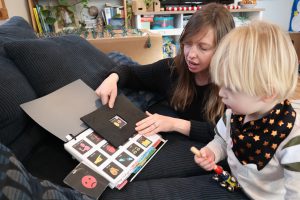Rebecca Miner thinks about community – community for her son, Everett. How will he make friends, when he cannot speak? How will he be included, if other parents are fearful their homes aren’t ‘set up’ for his needs? How can he play with other children at the playground, when mothers pull their kids away from his gait trainer? “They’re doing it to be polite,” Rebecca explained. “But really, the message they are sending to their kids is to not interact with him.”
Everett has Pitt-Hopkins syndrome. As a baby, he wasn’t very different from other little ones his age. But now, at two and a half, their paths are diverging. So how can relationships be built and maintained?
One answer: make it a top priority to teach Everett how to communicate. “Since going down this road, you just realize all of the assumptions that are made, incorrectly, when someone is not able to communicate verbally,” Rebecca said. “Communication is going to be crucial for him.”
Pitt-Hopkins is a rare genetic disorder affecting intellectual development and motor coordination; there is a high likelihood Everett will be nonverbal. With that in mind, the Miners concentrate daily on teaching their son to communicate using a modified version of the PODD system (Pragmatic Organisation Dynamic Display). PODD is a communication method created by Gayle Porter, an Australian speech language pathologist who has spent a 30-year career working with people with complex communication needs.
Like other communication systems, PODD provides a vocabulary using words or symbols. PODD can be used as a communication book, or in an electronic format via a Tobii Dynavox app called Compass (for iOS).

In Everett’s case, his parents use a physical book as a starting point to learn the symbols and pathways together. One clever innovation that makes turn-taking with communication partners easy: the Miners have strapped a communication board to a lazy susan, so that the board can be easily turned between Everett and his communication partner. Printing a select number of communication symbols from his PODD book to use on his board also allows the Miners quick and easy access to symbols they will be using frequently with Everett.
With PODD, the communicator always starts with the same first page. The choice made on that page will indicate another page for more related word choices. Because Everett is just beginning to learn, his parents are primarily modeling the use of the cards and the book, manipulating the pages for him.

If Everett remains nonverbal, or with limited speech, Rebecca trusts PODD will help him make himself known. “My fear is that someone is going to focus on his challenges and not pick up on the fact that he’s a little boy who loves interacting with people, loves his toys, loves his books,” she confided. “Communication will be his window for sharing his feelings, his challenges, and his joys with other people. Just because Everett has Pitt Hopkins doesn’t mean he should be denied that.”
Recently, the Miners had a family with a three-year-old daughter over for dinner. Their tiny guest was intrigued by Everett’s communication cards. “It made my heart so happy that she wanted to use the cards,” Rebecca said. “Everett really cued into that, so much more than just having me use them all the time.” That peer interest felt hopeful. Maybe building community for, and with, Everett isn’t going to be so hard after all.

